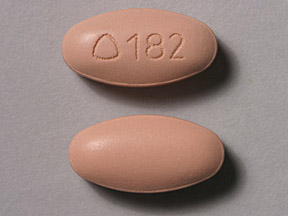Tarka Side Effects
Generic name: trandolapril / verapamil
Medically reviewed by Drugs.com. Last updated on Jan 9, 2024.
Note: This document contains side effect information about trandolapril / verapamil. Some dosage forms listed on this page may not apply to the brand name Tarka.
Applies to trandolapril / verapamil: oral tablet extended release.
Warning
Oral route (Tablet, Extended Release)
Discontinue treatment with trandolapril/verapamil hydrochloride as soon as possible when pregnancy is detected, since fetal toxicity, including injury and death to the developing fetus, can be caused by drugs that act directly on the renin-angiotensin system.
Serious side effects of Tarka
Along with its needed effects, trandolapril / verapamil may cause some unwanted effects. Although not all of these side effects may occur, if they do occur they may need medical attention.
Check with your doctor immediately if any of the following side effects occur while taking trandolapril / verapamil:
Rare
- Chest pain
- chills
- cough (with mucus)
- dark urine
- fever
- general feeling of discomfort or illness
- lightheadedness or fainting
- pain in the right side of the abdomen or stomach
- slow heartbeat
- sore throat
- swelling of the face, mouth, hands, or feet
- trouble in swallowing or breathing (sudden) accompanied by hoarseness
- yellow eyes or skin
Other side effects of Tarka
Some side effects of trandolapril / verapamil may occur that usually do not need medical attention. These side effects may go away during treatment as your body adjusts to the medicine. Also, your health care professional may be able to tell you about ways to prevent or reduce some of these side effects.
Check with your health care professional if any of the following side effects continue or are bothersome or if you have any questions about them:
Less common or rare
- Constipation
- cough (dry, continuous)
- diarrhea
- dizziness
- itching
- joint pain or pain in the arms or legs
- nausea
- unusual tiredness
For Healthcare Professionals
Applies to trandolapril / verapamil: oral tablet extended release.
General
The most common adverse reactions were headache, upper respiratory tract infection, cough, atrioventricular block first degree, constipation, and dizziness.[Ref]
Respiratory
Common (1% to 10%): Upper respiratory tract infection, cough, dyspnea, bronchitis, upper respiratory tract congestion
Frequency not reported: Epistaxis
Verapamil:
Frequency not reported: Pulmonary edema[Ref]
Other
Common (1% to 10%): Asthenia/weakness, chest pain, edema, fatigue
Frequency not reported: Malaise
Verapamil:
Frequency not reported: Gynecomastia[Ref]
Gastrointestinal
Common (1% to 10%): Constipation, nausea, diarrhea
Frequency not reported: Dyspepsia, dry mouth
Trandolapril:
Frequency not reported: Pancreatitis
Verapamil:
Frequency not reported: Gingival hyperplasia, reversible nonobstructive paralytic ileus[Ref]
Musculoskeletal
Common (1% to 10%): Pain back, pain extremity, pain joint
Frequency not reported: Arthralgias/myalgias[Ref]
Cardiovascular
Common (1% to 10%): Atrioventricular (AV) block first degree, bradycardia
Uncommon (0.1% to 1%): Hypotension
Frequency not reported: Angina, AV block second degree, bundle branch block, flushing, myocardial infarction, palpitation, premature ventricular contraction, nonspecific ST-T changes, tachycardia
Verapamil:
Frequency not reported: Congestive heart failure, AV block third degree, AV dissociation, claudication, vasculitis[Ref]
Nervous system
There has been one postmarketing report of paralysis (tetraparesis) with verapamil, which may have been caused by concomitant use of colchicine.[Ref]
Common (1% to 10%): Headache, dizziness
Uncommon (0.1% to 1%): Near syncope
Frequency not reported: Drowsiness, hypesthesia, loss of balance, paresthesia, vertigo, tinnitus
Verapamil:
Frequency not reported: Syncope, cerebrovascular accident, shakiness, somnolence
Postmarketing reports: Tetraparesis[Ref]
Renal
Common (1% to 10%): Creatinine increased
Uncommon (0.1% to 1%): BUN increased[Ref]
Metabolic
Common (1% to 10%): Hyperlipidemia
Frequency not reported: Gout, uric acid increased, hyperkalemia, hyponatremia[Ref]
Hepatic
Common (1% to 10%): Liver enzymes increased
Frequency not reported: Serum bilirubin increased[Ref]
Immunologic
Common (1% to 10%): Influenza[Ref]
Dermatologic
Uncommon (0.1% to 1%): Angioedema
Frequency not reported: Pruritus, rash
Verapamil:
Frequency not reported: Purpura, ecchymosis, exanthema, hair loss, hyperkeratosis, maculae, Stevens-Johnson syndrome, erythema multiform[Ref]
Genitourinary
Frequency not reported: Impotence, endometriosis, hematuria, nocturia, polyuria, proteinuria
Verapamil:
Frequency not reported: Urination increased, menstruation spotty[Ref]
Hematologic
Frequency not reported: Leukocytes decreased, neutrophils decreased, white blood cells low, neutrophils low, lymphocytes low, platelets low[Ref]
Psychiatric
Frequency not reported: Insomnia, anxiety, mentation abnormal
Trandolapril:
Frequency not reported: Libido decreased
Verapamil:
Frequency not reported: Confusion, psychotic symptoms[Ref]
Ocular
Frequency not reported: Vision blurred[Ref]
Endocrine
Verapamil:
Frequency not reported: Galactorrhea/hyperprolactinemia[Ref]
More about Tarka (trandolapril / verapamil)
- Check interactions
- Compare alternatives
- Reviews (5)
- Drug images
- Dosage information
- During pregnancy
- Drug class: ACE inhibitors with calcium channel blocking agents
Patient resources
Professional resources
Related treatment guides
References
1. Product Information. Tarka (trandolapril-verapamil). Knoll Pharmaceutical Company. 2001;PROD.
2. Cerner Multum, Inc. UK Summary of Product Characteristics.
3. Cerner Multum, Inc. Australian Product Information.
Further information
Always consult your healthcare provider to ensure the information displayed on this page applies to your personal circumstances.
Some side effects may not be reported. You may report them to the FDA.

